Exploring the Dynamics of Attitudes and Behaviors in the Workplace
VerifiedAdded on 2020/04/01
|8
|2318
|794
Essay
AI Summary
This essay provides a comprehensive analysis of attitudes and behaviors in the workplace, emphasizing their impact on employee performance and organizational commitment. It explores the three-component model of attitudes (cognitive, affective, and behavioral) and identifies four key attitudes (utilitarian, ego-defensive, value-expressive, and knowledge) that shape workplace behaviors. The essay discusses the influence of positive and negative attitudes on productivity, decision-making, stress management, and customer relations. Furthermore, it highlights factors that contribute to job satisfaction and commitment, such as training, career opportunities, rewards, work-life balance, and supportive leadership. The importance of organizational commitment and the role of managers in fostering it through clear goals, supportive strategies, and a challenging environment are also emphasized. The essay concludes by underscoring the significance of understanding and managing workplace attitudes to enhance employee performance, reduce turnover, and achieve organizational success.
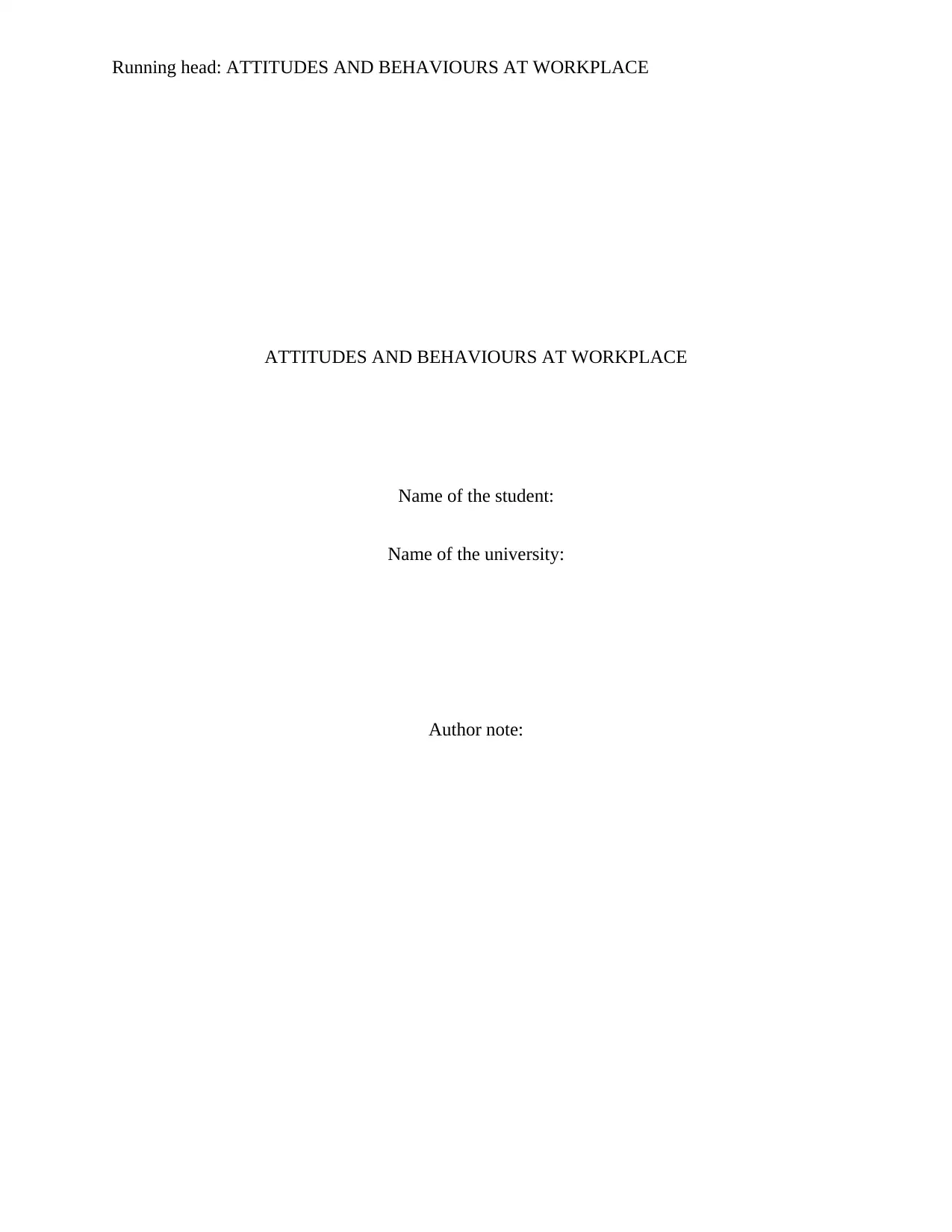
Running head: ATTITUDES AND BEHAVIOURS AT WORKPLACE
ATTITUDES AND BEHAVIOURS AT WORKPLACE
Name of the student:
Name of the university:
Author note:
ATTITUDES AND BEHAVIOURS AT WORKPLACE
Name of the student:
Name of the university:
Author note:
Paraphrase This Document
Need a fresh take? Get an instant paraphrase of this document with our AI Paraphraser
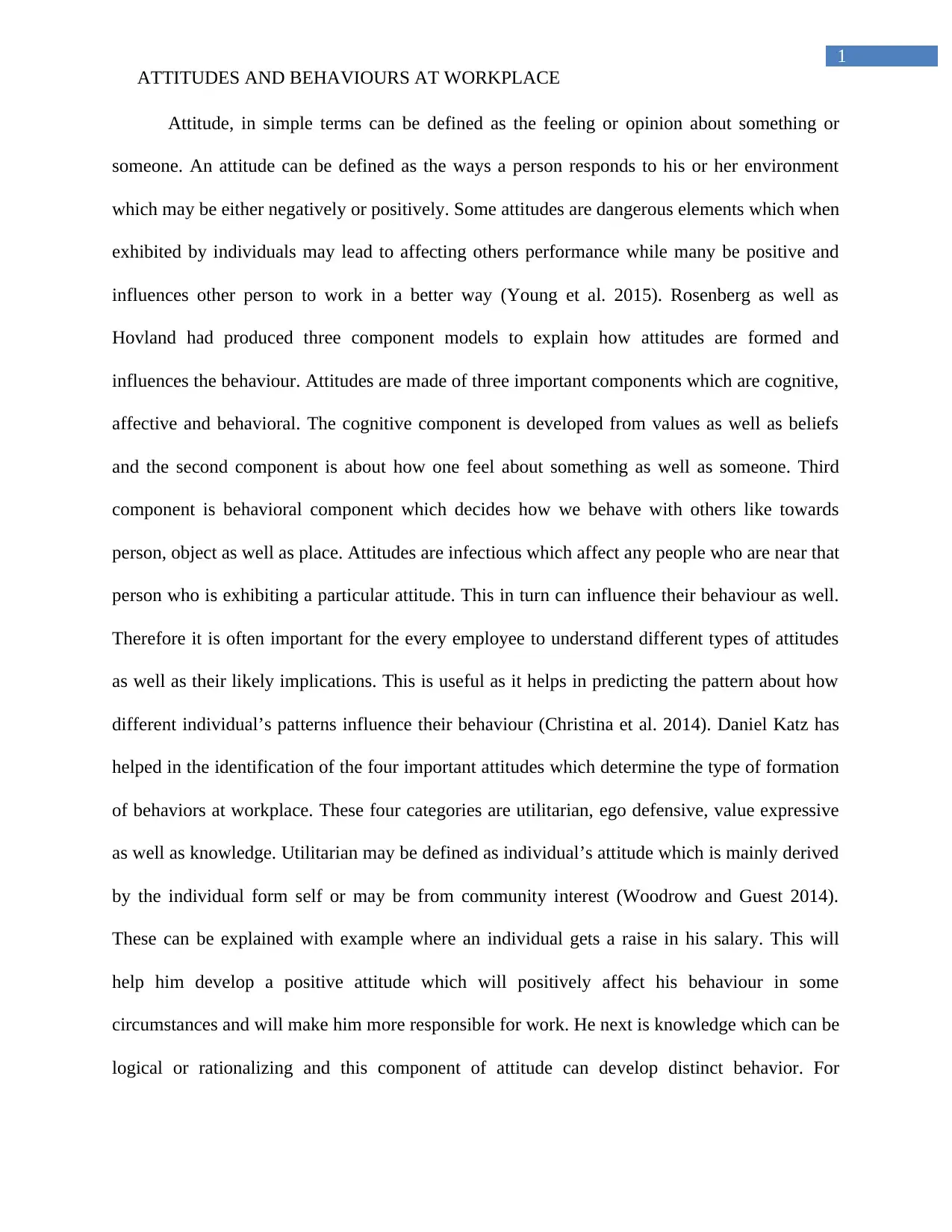
1
ATTITUDES AND BEHAVIOURS AT WORKPLACE
Attitude, in simple terms can be defined as the feeling or opinion about something or
someone. An attitude can be defined as the ways a person responds to his or her environment
which may be either negatively or positively. Some attitudes are dangerous elements which when
exhibited by individuals may lead to affecting others performance while many be positive and
influences other person to work in a better way (Young et al. 2015). Rosenberg as well as
Hovland had produced three component models to explain how attitudes are formed and
influences the behaviour. Attitudes are made of three important components which are cognitive,
affective and behavioral. The cognitive component is developed from values as well as beliefs
and the second component is about how one feel about something as well as someone. Third
component is behavioral component which decides how we behave with others like towards
person, object as well as place. Attitudes are infectious which affect any people who are near that
person who is exhibiting a particular attitude. This in turn can influence their behaviour as well.
Therefore it is often important for the every employee to understand different types of attitudes
as well as their likely implications. This is useful as it helps in predicting the pattern about how
different individual’s patterns influence their behaviour (Christina et al. 2014). Daniel Katz has
helped in the identification of the four important attitudes which determine the type of formation
of behaviors at workplace. These four categories are utilitarian, ego defensive, value expressive
as well as knowledge. Utilitarian may be defined as individual’s attitude which is mainly derived
by the individual form self or may be from community interest (Woodrow and Guest 2014).
These can be explained with example where an individual gets a raise in his salary. This will
help him develop a positive attitude which will positively affect his behaviour in some
circumstances and will make him more responsible for work. He next is knowledge which can be
logical or rationalizing and this component of attitude can develop distinct behavior. For
ATTITUDES AND BEHAVIOURS AT WORKPLACE
Attitude, in simple terms can be defined as the feeling or opinion about something or
someone. An attitude can be defined as the ways a person responds to his or her environment
which may be either negatively or positively. Some attitudes are dangerous elements which when
exhibited by individuals may lead to affecting others performance while many be positive and
influences other person to work in a better way (Young et al. 2015). Rosenberg as well as
Hovland had produced three component models to explain how attitudes are formed and
influences the behaviour. Attitudes are made of three important components which are cognitive,
affective and behavioral. The cognitive component is developed from values as well as beliefs
and the second component is about how one feel about something as well as someone. Third
component is behavioral component which decides how we behave with others like towards
person, object as well as place. Attitudes are infectious which affect any people who are near that
person who is exhibiting a particular attitude. This in turn can influence their behaviour as well.
Therefore it is often important for the every employee to understand different types of attitudes
as well as their likely implications. This is useful as it helps in predicting the pattern about how
different individual’s patterns influence their behaviour (Christina et al. 2014). Daniel Katz has
helped in the identification of the four important attitudes which determine the type of formation
of behaviors at workplace. These four categories are utilitarian, ego defensive, value expressive
as well as knowledge. Utilitarian may be defined as individual’s attitude which is mainly derived
by the individual form self or may be from community interest (Woodrow and Guest 2014).
These can be explained with example where an individual gets a raise in his salary. This will
help him develop a positive attitude which will positively affect his behaviour in some
circumstances and will make him more responsible for work. He next is knowledge which can be
logical or rationalizing and this component of attitude can develop distinct behavior. For
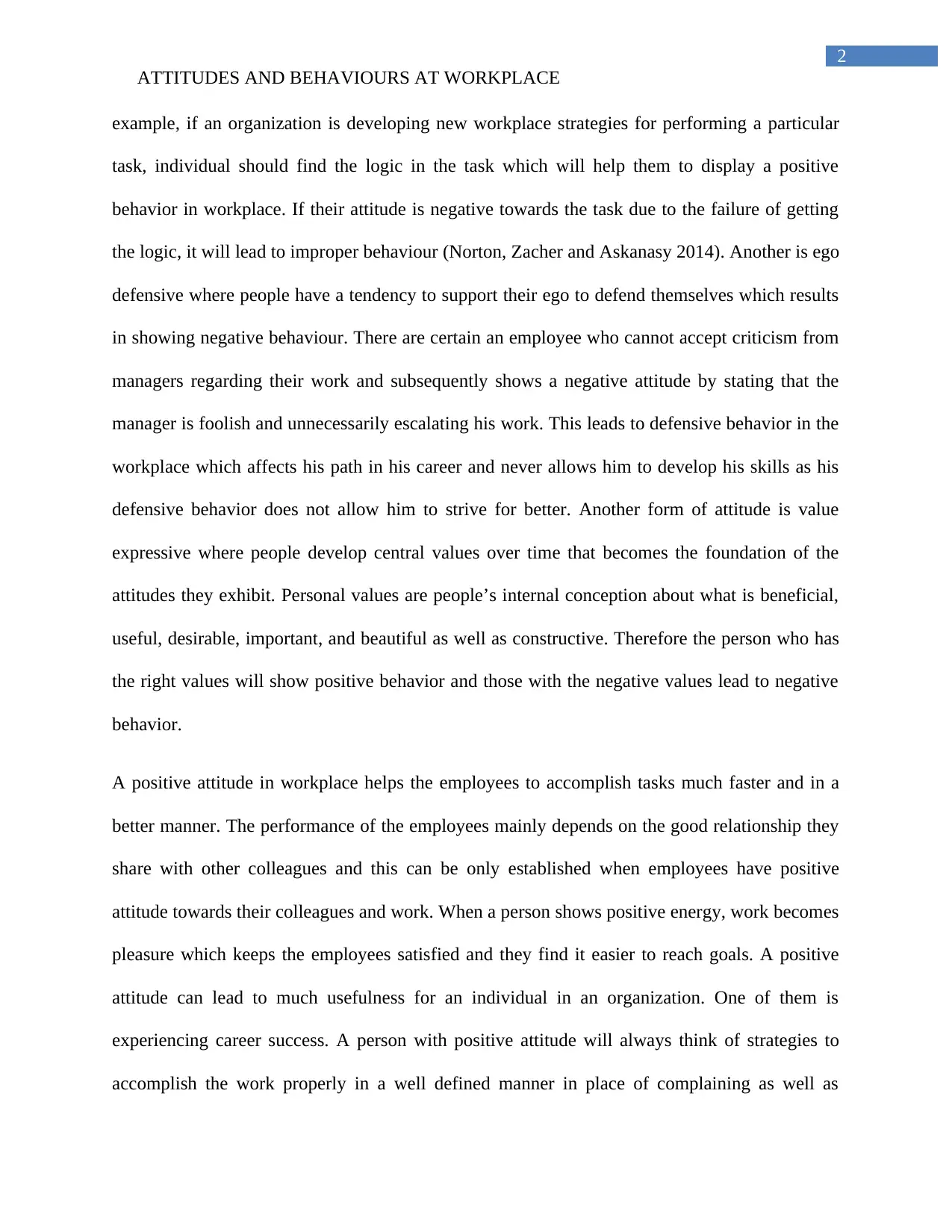
2
ATTITUDES AND BEHAVIOURS AT WORKPLACE
example, if an organization is developing new workplace strategies for performing a particular
task, individual should find the logic in the task which will help them to display a positive
behavior in workplace. If their attitude is negative towards the task due to the failure of getting
the logic, it will lead to improper behaviour (Norton, Zacher and Askanasy 2014). Another is ego
defensive where people have a tendency to support their ego to defend themselves which results
in showing negative behaviour. There are certain an employee who cannot accept criticism from
managers regarding their work and subsequently shows a negative attitude by stating that the
manager is foolish and unnecessarily escalating his work. This leads to defensive behavior in the
workplace which affects his path in his career and never allows him to develop his skills as his
defensive behavior does not allow him to strive for better. Another form of attitude is value
expressive where people develop central values over time that becomes the foundation of the
attitudes they exhibit. Personal values are people’s internal conception about what is beneficial,
useful, desirable, important, and beautiful as well as constructive. Therefore the person who has
the right values will show positive behavior and those with the negative values lead to negative
behavior.
A positive attitude in workplace helps the employees to accomplish tasks much faster and in a
better manner. The performance of the employees mainly depends on the good relationship they
share with other colleagues and this can be only established when employees have positive
attitude towards their colleagues and work. When a person shows positive energy, work becomes
pleasure which keeps the employees satisfied and they find it easier to reach goals. A positive
attitude can lead to much usefulness for an individual in an organization. One of them is
experiencing career success. A person with positive attitude will always think of strategies to
accomplish the work properly in a well defined manner in place of complaining as well as
ATTITUDES AND BEHAVIOURS AT WORKPLACE
example, if an organization is developing new workplace strategies for performing a particular
task, individual should find the logic in the task which will help them to display a positive
behavior in workplace. If their attitude is negative towards the task due to the failure of getting
the logic, it will lead to improper behaviour (Norton, Zacher and Askanasy 2014). Another is ego
defensive where people have a tendency to support their ego to defend themselves which results
in showing negative behaviour. There are certain an employee who cannot accept criticism from
managers regarding their work and subsequently shows a negative attitude by stating that the
manager is foolish and unnecessarily escalating his work. This leads to defensive behavior in the
workplace which affects his path in his career and never allows him to develop his skills as his
defensive behavior does not allow him to strive for better. Another form of attitude is value
expressive where people develop central values over time that becomes the foundation of the
attitudes they exhibit. Personal values are people’s internal conception about what is beneficial,
useful, desirable, important, and beautiful as well as constructive. Therefore the person who has
the right values will show positive behavior and those with the negative values lead to negative
behavior.
A positive attitude in workplace helps the employees to accomplish tasks much faster and in a
better manner. The performance of the employees mainly depends on the good relationship they
share with other colleagues and this can be only established when employees have positive
attitude towards their colleagues and work. When a person shows positive energy, work becomes
pleasure which keeps the employees satisfied and they find it easier to reach goals. A positive
attitude can lead to much usefulness for an individual in an organization. One of them is
experiencing career success. A person with positive attitude will always think of strategies to
accomplish the work properly in a well defined manner in place of complaining as well as
⊘ This is a preview!⊘
Do you want full access?
Subscribe today to unlock all pages.

Trusted by 1+ million students worldwide
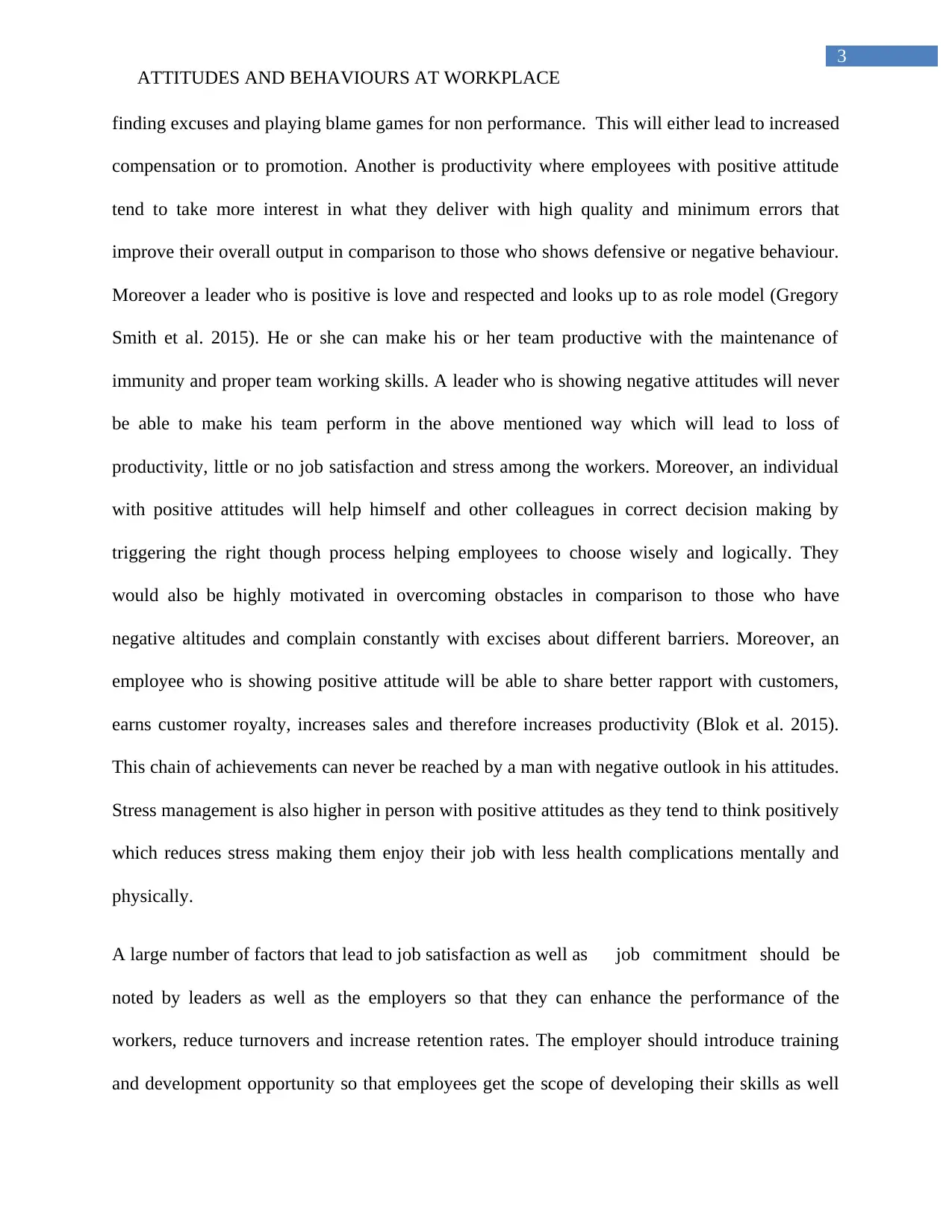
3
ATTITUDES AND BEHAVIOURS AT WORKPLACE
finding excuses and playing blame games for non performance. This will either lead to increased
compensation or to promotion. Another is productivity where employees with positive attitude
tend to take more interest in what they deliver with high quality and minimum errors that
improve their overall output in comparison to those who shows defensive or negative behaviour.
Moreover a leader who is positive is love and respected and looks up to as role model (Gregory
Smith et al. 2015). He or she can make his or her team productive with the maintenance of
immunity and proper team working skills. A leader who is showing negative attitudes will never
be able to make his team perform in the above mentioned way which will lead to loss of
productivity, little or no job satisfaction and stress among the workers. Moreover, an individual
with positive attitudes will help himself and other colleagues in correct decision making by
triggering the right though process helping employees to choose wisely and logically. They
would also be highly motivated in overcoming obstacles in comparison to those who have
negative altitudes and complain constantly with excises about different barriers. Moreover, an
employee who is showing positive attitude will be able to share better rapport with customers,
earns customer royalty, increases sales and therefore increases productivity (Blok et al. 2015).
This chain of achievements can never be reached by a man with negative outlook in his attitudes.
Stress management is also higher in person with positive attitudes as they tend to think positively
which reduces stress making them enjoy their job with less health complications mentally and
physically.
A large number of factors that lead to job satisfaction as well as job commitment should be
noted by leaders as well as the employers so that they can enhance the performance of the
workers, reduce turnovers and increase retention rates. The employer should introduce training
and development opportunity so that employees get the scope of developing their skills as well
ATTITUDES AND BEHAVIOURS AT WORKPLACE
finding excuses and playing blame games for non performance. This will either lead to increased
compensation or to promotion. Another is productivity where employees with positive attitude
tend to take more interest in what they deliver with high quality and minimum errors that
improve their overall output in comparison to those who shows defensive or negative behaviour.
Moreover a leader who is positive is love and respected and looks up to as role model (Gregory
Smith et al. 2015). He or she can make his or her team productive with the maintenance of
immunity and proper team working skills. A leader who is showing negative attitudes will never
be able to make his team perform in the above mentioned way which will lead to loss of
productivity, little or no job satisfaction and stress among the workers. Moreover, an individual
with positive attitudes will help himself and other colleagues in correct decision making by
triggering the right though process helping employees to choose wisely and logically. They
would also be highly motivated in overcoming obstacles in comparison to those who have
negative altitudes and complain constantly with excises about different barriers. Moreover, an
employee who is showing positive attitude will be able to share better rapport with customers,
earns customer royalty, increases sales and therefore increases productivity (Blok et al. 2015).
This chain of achievements can never be reached by a man with negative outlook in his attitudes.
Stress management is also higher in person with positive attitudes as they tend to think positively
which reduces stress making them enjoy their job with less health complications mentally and
physically.
A large number of factors that lead to job satisfaction as well as job commitment should be
noted by leaders as well as the employers so that they can enhance the performance of the
workers, reduce turnovers and increase retention rates. The employer should introduce training
and development opportunity so that employees get the scope of developing their skills as well
Paraphrase This Document
Need a fresh take? Get an instant paraphrase of this document with our AI Paraphraser
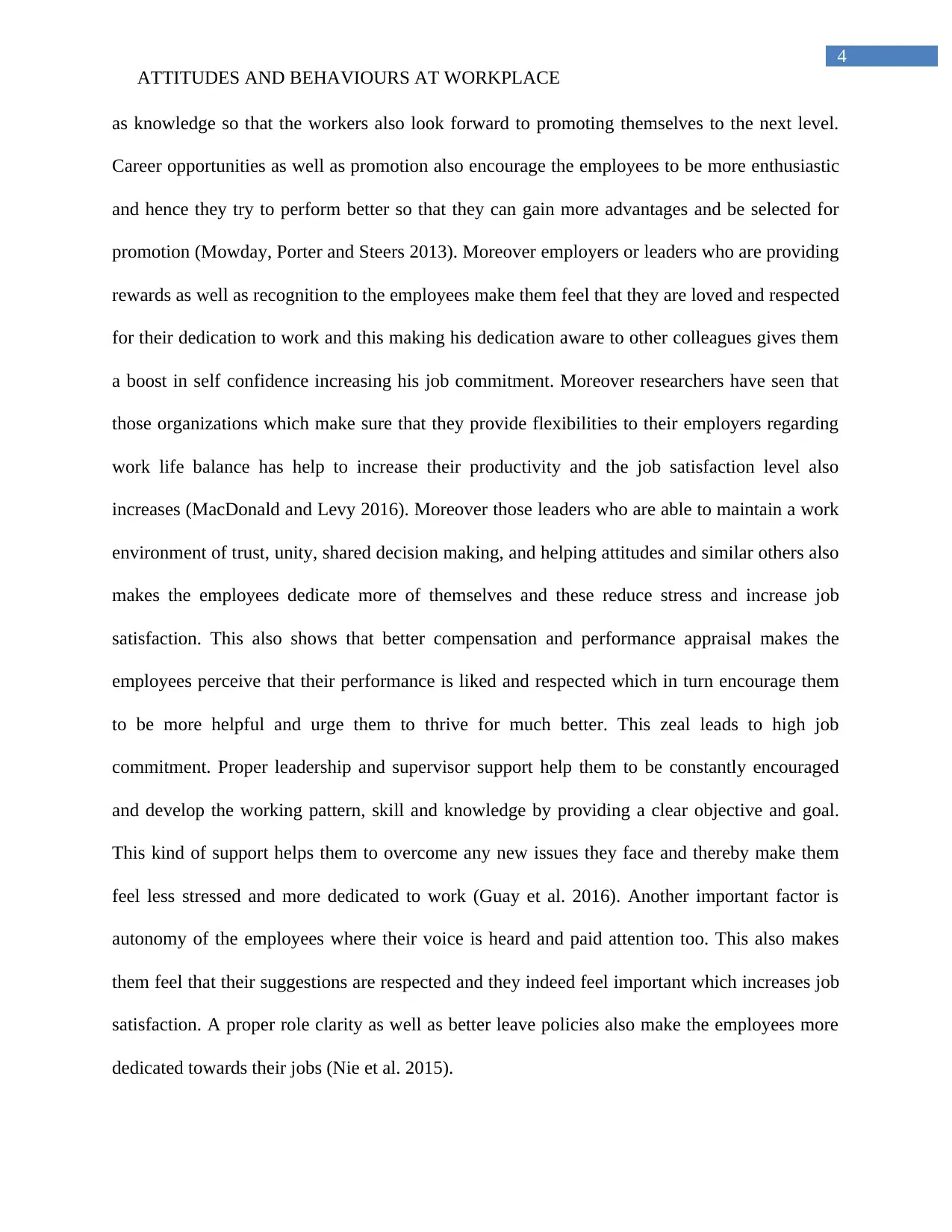
4
ATTITUDES AND BEHAVIOURS AT WORKPLACE
as knowledge so that the workers also look forward to promoting themselves to the next level.
Career opportunities as well as promotion also encourage the employees to be more enthusiastic
and hence they try to perform better so that they can gain more advantages and be selected for
promotion (Mowday, Porter and Steers 2013). Moreover employers or leaders who are providing
rewards as well as recognition to the employees make them feel that they are loved and respected
for their dedication to work and this making his dedication aware to other colleagues gives them
a boost in self confidence increasing his job commitment. Moreover researchers have seen that
those organizations which make sure that they provide flexibilities to their employers regarding
work life balance has help to increase their productivity and the job satisfaction level also
increases (MacDonald and Levy 2016). Moreover those leaders who are able to maintain a work
environment of trust, unity, shared decision making, and helping attitudes and similar others also
makes the employees dedicate more of themselves and these reduce stress and increase job
satisfaction. This also shows that better compensation and performance appraisal makes the
employees perceive that their performance is liked and respected which in turn encourage them
to be more helpful and urge them to thrive for much better. This zeal leads to high job
commitment. Proper leadership and supervisor support help them to be constantly encouraged
and develop the working pattern, skill and knowledge by providing a clear objective and goal.
This kind of support helps them to overcome any new issues they face and thereby make them
feel less stressed and more dedicated to work (Guay et al. 2016). Another important factor is
autonomy of the employees where their voice is heard and paid attention too. This also makes
them feel that their suggestions are respected and they indeed feel important which increases job
satisfaction. A proper role clarity as well as better leave policies also make the employees more
dedicated towards their jobs (Nie et al. 2015).
ATTITUDES AND BEHAVIOURS AT WORKPLACE
as knowledge so that the workers also look forward to promoting themselves to the next level.
Career opportunities as well as promotion also encourage the employees to be more enthusiastic
and hence they try to perform better so that they can gain more advantages and be selected for
promotion (Mowday, Porter and Steers 2013). Moreover employers or leaders who are providing
rewards as well as recognition to the employees make them feel that they are loved and respected
for their dedication to work and this making his dedication aware to other colleagues gives them
a boost in self confidence increasing his job commitment. Moreover researchers have seen that
those organizations which make sure that they provide flexibilities to their employers regarding
work life balance has help to increase their productivity and the job satisfaction level also
increases (MacDonald and Levy 2016). Moreover those leaders who are able to maintain a work
environment of trust, unity, shared decision making, and helping attitudes and similar others also
makes the employees dedicate more of themselves and these reduce stress and increase job
satisfaction. This also shows that better compensation and performance appraisal makes the
employees perceive that their performance is liked and respected which in turn encourage them
to be more helpful and urge them to thrive for much better. This zeal leads to high job
commitment. Proper leadership and supervisor support help them to be constantly encouraged
and develop the working pattern, skill and knowledge by providing a clear objective and goal.
This kind of support helps them to overcome any new issues they face and thereby make them
feel less stressed and more dedicated to work (Guay et al. 2016). Another important factor is
autonomy of the employees where their voice is heard and paid attention too. This also makes
them feel that their suggestions are respected and they indeed feel important which increases job
satisfaction. A proper role clarity as well as better leave policies also make the employees more
dedicated towards their jobs (Nie et al. 2015).
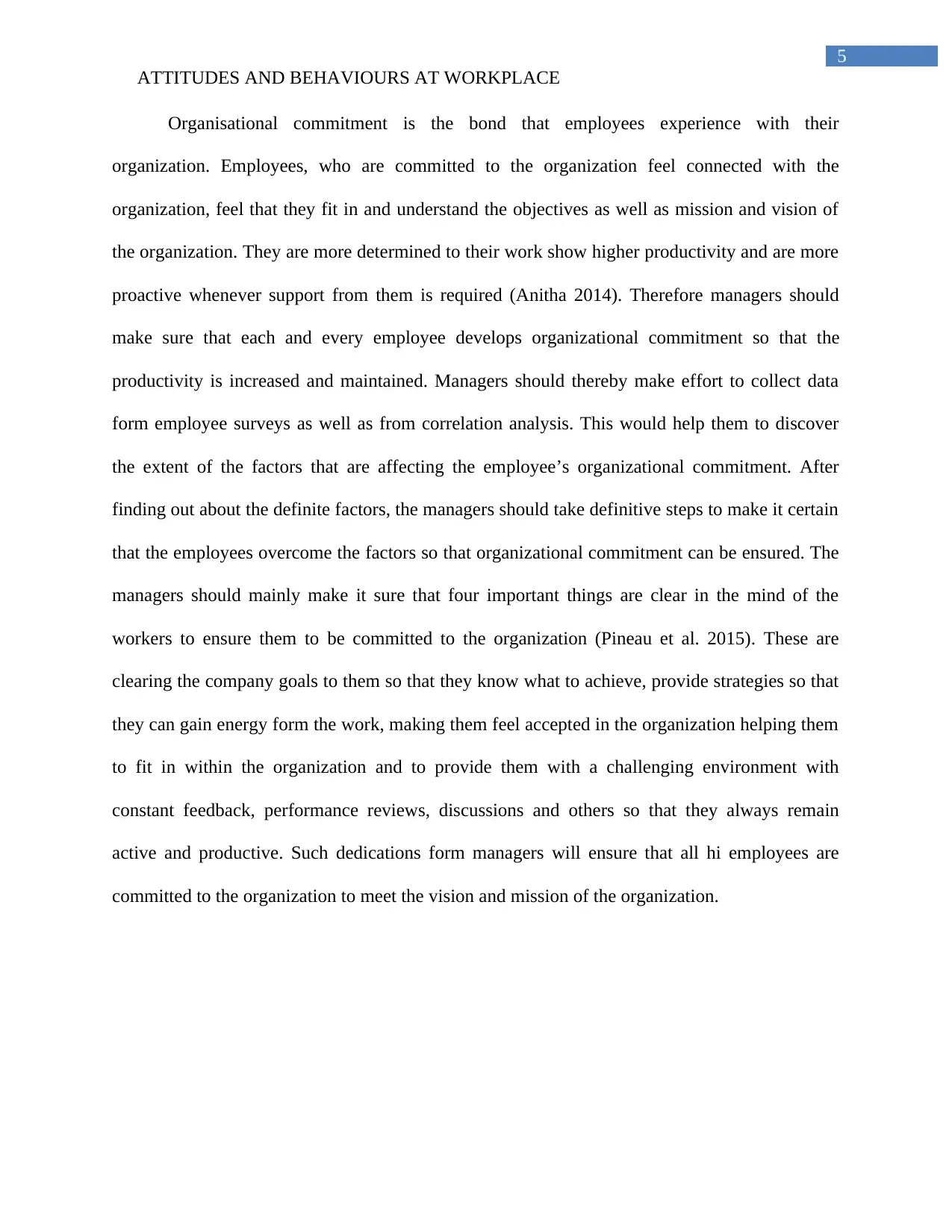
5
ATTITUDES AND BEHAVIOURS AT WORKPLACE
Organisational commitment is the bond that employees experience with their
organization. Employees, who are committed to the organization feel connected with the
organization, feel that they fit in and understand the objectives as well as mission and vision of
the organization. They are more determined to their work show higher productivity and are more
proactive whenever support from them is required (Anitha 2014). Therefore managers should
make sure that each and every employee develops organizational commitment so that the
productivity is increased and maintained. Managers should thereby make effort to collect data
form employee surveys as well as from correlation analysis. This would help them to discover
the extent of the factors that are affecting the employee’s organizational commitment. After
finding out about the definite factors, the managers should take definitive steps to make it certain
that the employees overcome the factors so that organizational commitment can be ensured. The
managers should mainly make it sure that four important things are clear in the mind of the
workers to ensure them to be committed to the organization (Pineau et al. 2015). These are
clearing the company goals to them so that they know what to achieve, provide strategies so that
they can gain energy form the work, making them feel accepted in the organization helping them
to fit in within the organization and to provide them with a challenging environment with
constant feedback, performance reviews, discussions and others so that they always remain
active and productive. Such dedications form managers will ensure that all hi employees are
committed to the organization to meet the vision and mission of the organization.
ATTITUDES AND BEHAVIOURS AT WORKPLACE
Organisational commitment is the bond that employees experience with their
organization. Employees, who are committed to the organization feel connected with the
organization, feel that they fit in and understand the objectives as well as mission and vision of
the organization. They are more determined to their work show higher productivity and are more
proactive whenever support from them is required (Anitha 2014). Therefore managers should
make sure that each and every employee develops organizational commitment so that the
productivity is increased and maintained. Managers should thereby make effort to collect data
form employee surveys as well as from correlation analysis. This would help them to discover
the extent of the factors that are affecting the employee’s organizational commitment. After
finding out about the definite factors, the managers should take definitive steps to make it certain
that the employees overcome the factors so that organizational commitment can be ensured. The
managers should mainly make it sure that four important things are clear in the mind of the
workers to ensure them to be committed to the organization (Pineau et al. 2015). These are
clearing the company goals to them so that they know what to achieve, provide strategies so that
they can gain energy form the work, making them feel accepted in the organization helping them
to fit in within the organization and to provide them with a challenging environment with
constant feedback, performance reviews, discussions and others so that they always remain
active and productive. Such dedications form managers will ensure that all hi employees are
committed to the organization to meet the vision and mission of the organization.
⊘ This is a preview!⊘
Do you want full access?
Subscribe today to unlock all pages.

Trusted by 1+ million students worldwide
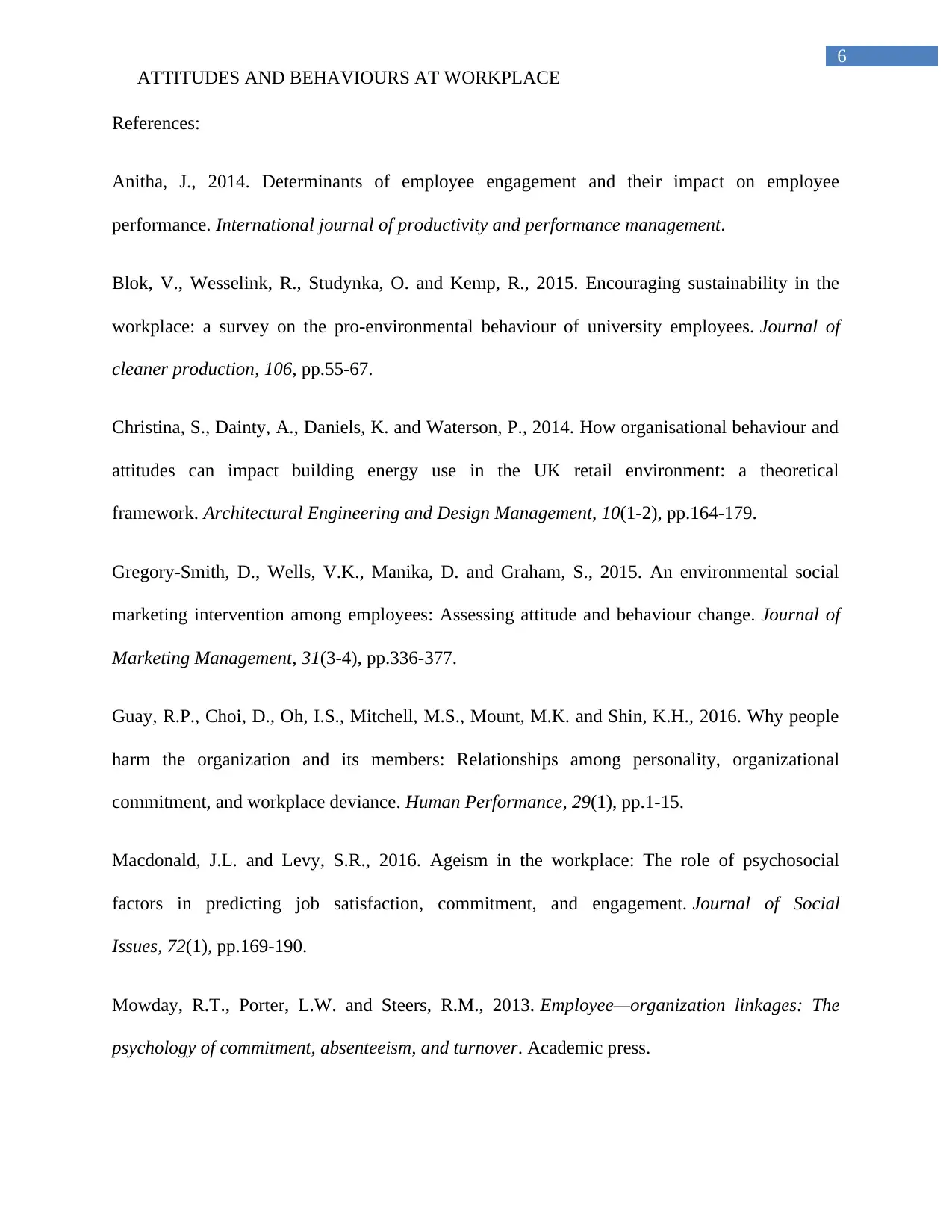
6
ATTITUDES AND BEHAVIOURS AT WORKPLACE
References:
Anitha, J., 2014. Determinants of employee engagement and their impact on employee
performance. International journal of productivity and performance management.
Blok, V., Wesselink, R., Studynka, O. and Kemp, R., 2015. Encouraging sustainability in the
workplace: a survey on the pro-environmental behaviour of university employees. Journal of
cleaner production, 106, pp.55-67.
Christina, S., Dainty, A., Daniels, K. and Waterson, P., 2014. How organisational behaviour and
attitudes can impact building energy use in the UK retail environment: a theoretical
framework. Architectural Engineering and Design Management, 10(1-2), pp.164-179.
Gregory-Smith, D., Wells, V.K., Manika, D. and Graham, S., 2015. An environmental social
marketing intervention among employees: Assessing attitude and behaviour change. Journal of
Marketing Management, 31(3-4), pp.336-377.
Guay, R.P., Choi, D., Oh, I.S., Mitchell, M.S., Mount, M.K. and Shin, K.H., 2016. Why people
harm the organization and its members: Relationships among personality, organizational
commitment, and workplace deviance. Human Performance, 29(1), pp.1-15.
Macdonald, J.L. and Levy, S.R., 2016. Ageism in the workplace: The role of psychosocial
factors in predicting job satisfaction, commitment, and engagement. Journal of Social
Issues, 72(1), pp.169-190.
Mowday, R.T., Porter, L.W. and Steers, R.M., 2013. Employee—organization linkages: The
psychology of commitment, absenteeism, and turnover. Academic press.
ATTITUDES AND BEHAVIOURS AT WORKPLACE
References:
Anitha, J., 2014. Determinants of employee engagement and their impact on employee
performance. International journal of productivity and performance management.
Blok, V., Wesselink, R., Studynka, O. and Kemp, R., 2015. Encouraging sustainability in the
workplace: a survey on the pro-environmental behaviour of university employees. Journal of
cleaner production, 106, pp.55-67.
Christina, S., Dainty, A., Daniels, K. and Waterson, P., 2014. How organisational behaviour and
attitudes can impact building energy use in the UK retail environment: a theoretical
framework. Architectural Engineering and Design Management, 10(1-2), pp.164-179.
Gregory-Smith, D., Wells, V.K., Manika, D. and Graham, S., 2015. An environmental social
marketing intervention among employees: Assessing attitude and behaviour change. Journal of
Marketing Management, 31(3-4), pp.336-377.
Guay, R.P., Choi, D., Oh, I.S., Mitchell, M.S., Mount, M.K. and Shin, K.H., 2016. Why people
harm the organization and its members: Relationships among personality, organizational
commitment, and workplace deviance. Human Performance, 29(1), pp.1-15.
Macdonald, J.L. and Levy, S.R., 2016. Ageism in the workplace: The role of psychosocial
factors in predicting job satisfaction, commitment, and engagement. Journal of Social
Issues, 72(1), pp.169-190.
Mowday, R.T., Porter, L.W. and Steers, R.M., 2013. Employee—organization linkages: The
psychology of commitment, absenteeism, and turnover. Academic press.
Paraphrase This Document
Need a fresh take? Get an instant paraphrase of this document with our AI Paraphraser
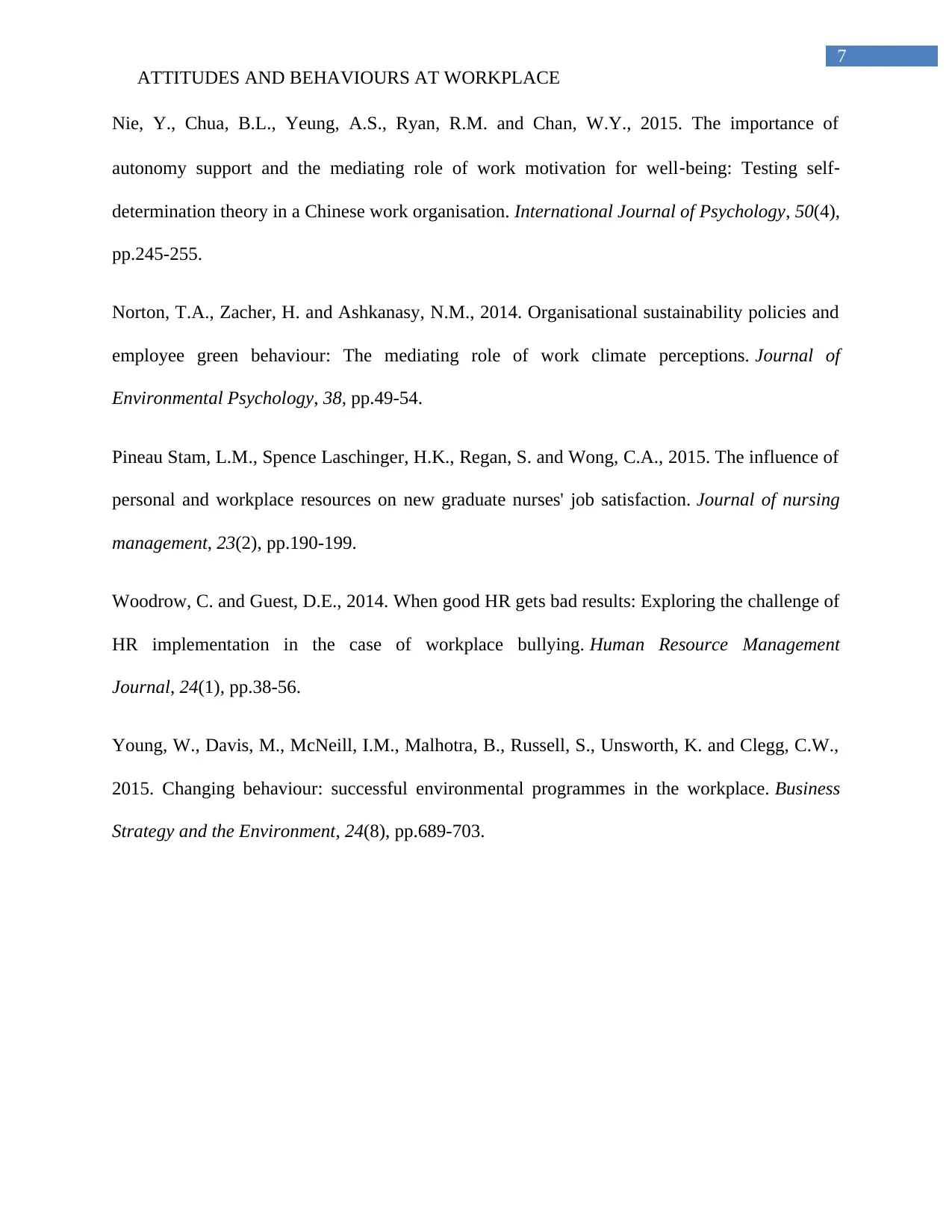
7
ATTITUDES AND BEHAVIOURS AT WORKPLACE
Nie, Y., Chua, B.L., Yeung, A.S., Ryan, R.M. and Chan, W.Y., 2015. The importance of
autonomy support and the mediating role of work motivation for well‐being: Testing self‐
determination theory in a Chinese work organisation. International Journal of Psychology, 50(4),
pp.245-255.
Norton, T.A., Zacher, H. and Ashkanasy, N.M., 2014. Organisational sustainability policies and
employee green behaviour: The mediating role of work climate perceptions. Journal of
Environmental Psychology, 38, pp.49-54.
Pineau Stam, L.M., Spence Laschinger, H.K., Regan, S. and Wong, C.A., 2015. The influence of
personal and workplace resources on new graduate nurses' job satisfaction. Journal of nursing
management, 23(2), pp.190-199.
Woodrow, C. and Guest, D.E., 2014. When good HR gets bad results: Exploring the challenge of
HR implementation in the case of workplace bullying. Human Resource Management
Journal, 24(1), pp.38-56.
Young, W., Davis, M., McNeill, I.M., Malhotra, B., Russell, S., Unsworth, K. and Clegg, C.W.,
2015. Changing behaviour: successful environmental programmes in the workplace. Business
Strategy and the Environment, 24(8), pp.689-703.
ATTITUDES AND BEHAVIOURS AT WORKPLACE
Nie, Y., Chua, B.L., Yeung, A.S., Ryan, R.M. and Chan, W.Y., 2015. The importance of
autonomy support and the mediating role of work motivation for well‐being: Testing self‐
determination theory in a Chinese work organisation. International Journal of Psychology, 50(4),
pp.245-255.
Norton, T.A., Zacher, H. and Ashkanasy, N.M., 2014. Organisational sustainability policies and
employee green behaviour: The mediating role of work climate perceptions. Journal of
Environmental Psychology, 38, pp.49-54.
Pineau Stam, L.M., Spence Laschinger, H.K., Regan, S. and Wong, C.A., 2015. The influence of
personal and workplace resources on new graduate nurses' job satisfaction. Journal of nursing
management, 23(2), pp.190-199.
Woodrow, C. and Guest, D.E., 2014. When good HR gets bad results: Exploring the challenge of
HR implementation in the case of workplace bullying. Human Resource Management
Journal, 24(1), pp.38-56.
Young, W., Davis, M., McNeill, I.M., Malhotra, B., Russell, S., Unsworth, K. and Clegg, C.W.,
2015. Changing behaviour: successful environmental programmes in the workplace. Business
Strategy and the Environment, 24(8), pp.689-703.
1 out of 8
Related Documents
Your All-in-One AI-Powered Toolkit for Academic Success.
+13062052269
info@desklib.com
Available 24*7 on WhatsApp / Email
![[object Object]](/_next/static/media/star-bottom.7253800d.svg)
Unlock your academic potential
Copyright © 2020–2025 A2Z Services. All Rights Reserved. Developed and managed by ZUCOL.





